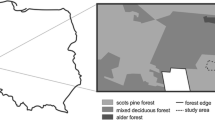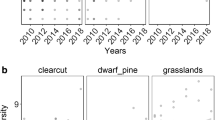Abstract
Three important parameters of biodiversity in first generation Scots pine (Pinus sylvestris) forests on sandy soils have been evaluated: herbal layer diversity, natural regeneration and stand structure. The study took place in the Belgian Campine region, where the original oak–birch forest, degraded to heathlands in the course of time, were finally replaced by monocultures of Scots pine. These first generation pine forests are characterized by a low biodiversity. In maturing stands of this type, however, a spontaneous increase of biodiversity is noticed. Herbal species richness is very limited in all age classes. Different natural regeneration patterns are found. Referring to stand structure, the lengthening of the rotation favours the ingrowth of several hardwood species. As a consequence, the homogenous Scots pine stands are gradually and spontaneously transformed into heterogeneous mixed stands, featuring a noticeable increase in biodiversity. Selected human interventions may further increase biodiversity. The fundamental management principles are discussed: avoidance of major disturbances, lengthening of the rotation period, use of native tree species and natural regeneration, protection of microbiotopes and permanent monitoring.
Similar content being viewed by others
References
Aichmüller, R. (1991) Aufbau reichgegliederter Waldränder. All-gemeine Forstzeitschrift 46, 707–9.
Boyle, T.B. (1991) Biodiversity of Canadian forests: current status and future challenges. The Forestry Chronicle 68(4) 444–52.
Bunnell, F.L. (1990) Biodiversity: What, where, why and how. In Wildlife Forestry Symposium (A. Chambers, ed.). Prince George, BC. For Res.
De Schepper, C. (1988) Typology of the natural regeneration in a middle-aged Scots pine forest. Silva Gandavensis 53, 29–60.
Fanta, J. (1995a) Beuk (Fagus sylvatica) in het Nederlandse deel van het nw.-Europees diluvium. Nederlands Bosbouw Tijdschrift 225–34.
Fanta, J. (1995b) Walddynamik in Flugsandgebieten des niederländischen Teiles des nordwesteuropäischen Diluviums. Forstarchiv 66, 128–32.
Hallé, F., Oldeman, R.A.A. and Tomlinson, P.B. (1978) Tropical trees and forests. An architectural analysis. Berlin: Springer Verlag, 414 pp.
Jedicke, E. (1991) Biotopverbund im Forst. Allgemeine Forstzeitschrift 46, 703–5.
Kennedy, C.E.J. and Southwood, T.R.E. (1984) The number of species of insects associated with British trees: a reanalysis. J. Anim. Ecol. 53, 455–78.
Kirbach, R. (1992) Auf dem Holzweg. Die Zeit 3, 25–6.
Koop, H. (1989) Forest dynamics. Silvi-Star: a comprehensive monitoring system. Berlin: Springer-Verlag, 229 pp.
Leibundgut, H. (1959) Über Zweck und Methodik der Struktur-und Zuwachsanalyse von Urwäl-dern. Schweiz. Z. für Forstwesen 110(3), 111–24.
Leibundgut, H. (1992) Ziele und Wege der naturnahen Waldwirtschaft. Schweiz. Z. für Forstwesen 137, 245–50.
Lust, N. (1987) An analysis of a spontaneous in growth of deciduous trees in 70 year old stands of Scots pine. Silva Gandavensis 52, 1–28.
Lust, N. (1988) Analysis of a natural regeneration of Scots pine forest in the High Campine after a fire. Silva Gandavensis 53, 3–28.
Lust, N. (1992) Forestry policy on multiple use forestry in Europe. Silva Gandavensis 57, 46–77.
Lust, N. (1993) Waldwirtschaft und Naturschutz auf Weltveranstaltungen und in der Praxis. Silva Gandavensis 58, 115–40.
Lust, N., Maddelein, D. and Meyen, S. (1989) Rehabilitation of forest ecosystem on former heathlands by a first generation of Scots pine. Silva Gandavensis 54, 3–12.
Maddelein, D. and Lust, N. (1992a) Silvicultural characteristics of a Scots pine stand on drift sands. Silva Gandavensis 57, 16–27.
Maddelein, D. and Lust, N. (1992b) Soil and forest floor characteristics of Scots pine sands on drift sands. Silva Gandavensis 57, 10–15.
Maddelein, D. and Neirynck, J. (1995) Omvorming van Kempische dennenbossen naar gemengde bestandstypes op basis van inlandse eik. Groene Band 97, 29 pp.
Maddelein, D., Lust, N., Meyen, S. and Muys, B. (1990) Dynamics in maturing Scots pine mono-cultures in North-East Belgium. Silva Gandavensis 55, 69–80.
Maddelein, D., Meyen, S. and Lust, N. (1991) Driving forces and limiting factors in long-term dynamics of forest ecosystems on sandy soils. Final report, Laboratory of Forestry. State University of Ghent, 223 pp.
Maddelein, D., Neirynck J. and Sioen, G. (1993) Growth and management of mixed Pinus silvestris, Quercus robur stands in Flanders, Belgium. Silva Gandavensis 58, 91–100.
Mlinsek, D. (1992) Zur Weiterentwicklung von Altersklassenwäldern. Oesterreichische Forstzeitung 103, 9–11.
Muys, B. (1991) Strooisel en humus: onbekend is onbemind. Groene Band 83–84, 11-35.
Oldeman, R.A.A. (1990) Forests: elements of silvicology. Berlin: Springer Verlag, 624 pp.
Otto, H.J. (1991) Forstökologie, Waldbau und Naturschutz. Allgemeine Forstzeitschrift 46, 9–14.
Peterken, G.F. (1981) Wooland conservation and management. London: Chapman & Hall, 328 pp.
Pflug, W. (1991) Wald, Naturschutz und Erholung. Allgemeine Forstzeitschrift 37, 1361.
Rogister, J.E. (1959) Ecologische en bosbouwkundige kartering van het domeinbos Pijnven. Edited by Proefstation Groenendaal, 63 pp.
Rohner, J. (1988) Wald und Waldwirtschaft aus der Sicht des Natureschutzes. Sweizerische Zeitschrift für Forsturesen 139, 1001–11.
Schoop, G. (1991) Multifunktionale Forstwirtschaft. Allgemeine Forstzeitschrift 46, 20–2.
Weber, T. (1984) Waldbewirtschaftung und Naturschutz. Der Forst u. Holzwirt 39, 531–4.
Author information
Authors and Affiliations
Rights and permissions
About this article
Cite this article
Lust, N., Muys, B. & Nachtergale, L. Increase of biodiversity in homogeneous Scots pine stands by an ecologically diversified management. Biodiversity and Conservation 7, 249–260 (1998). https://doi.org/10.1023/A:1008892620387
Issue Date:
DOI: https://doi.org/10.1023/A:1008892620387




